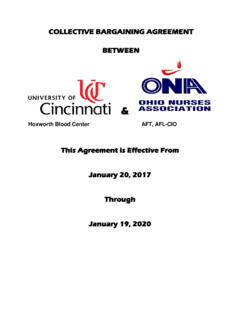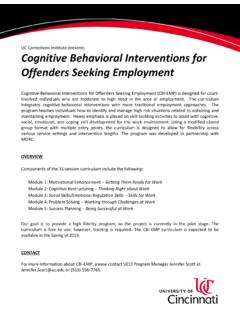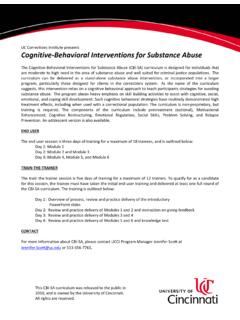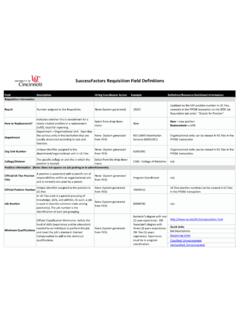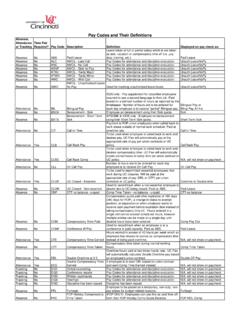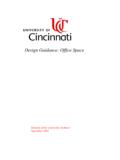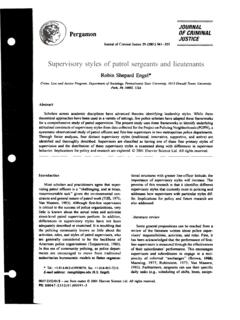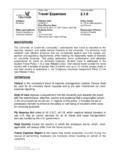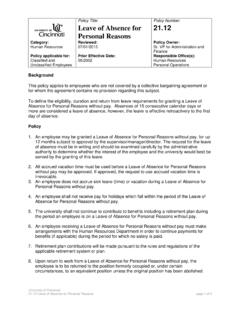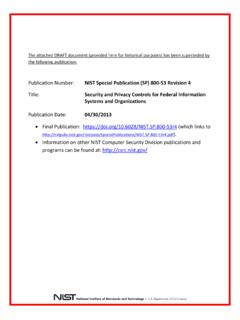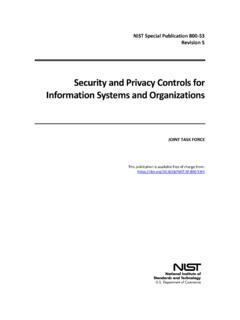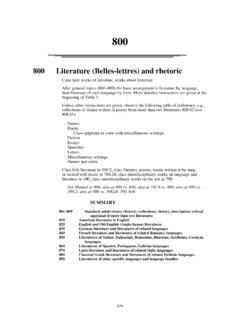Transcription of NIST 800-171 Compliance Guideline - University of …
1 NIST 800-171 Compliance Guideline Page 1 of 16 NIST 800-171 Compliance Guideline Background The National Institute of Standards and Technology (NIST) published the 800-171 security requirements, Protecting Controlled Unclassified Information in Nonfederal Information Systems and Organizations, in June 2015. The purpose of that publication is to provide guidance for government contractors to protect certain types of federal information. NIST 800-171 is a subset of security controls derived from the NIST 800-53 publication. This subset of security controls is required when a non-federal entity is sharing, collecting, processing, storing or transmitting Controlled Unclassified Information (CUI) on behalf of a federal government agency. The University most often encounters CUI when conducting research with data owned by a federal agency.
2 For example, all research projects governed by a Department of Defense (DoD) contract must be NIST 800-171 compliant as of December 2017. How to Use This Document This document was created as a best effort to assist members of the University community who must comply with NIST 800-171 . The 110 NIST 800-171 security controls are divided into 14 control families. Controls are mapped to appropriate University policies, standards or other documents where possible. Additional information related to controls can be found in NIST 800-53. It is important to note; University policies were developed independent of NIST 800-171 and may not meet NIST requirements. Conformity with the University policies mapped in this document does not infer NIST Compliance . Gaps may exist between University policy and NIST 800-171 controls.
3 In an effort to mitigate those gaps and achieve Compliance , the Primary Investigator (PI) must follow all NIST control requirements. Compliance with NIST 800-171 cannot be achieved by following University policy exclusively. The PI should work closely with local and central IT. Local and central IT may implement technical controls related to NIST but ultimately it is the responsibility of the PI to ensure NIST Compliance for their data and research equipment. NIST 800-171 Compliance Guideline Page 2 of 16 6 Steps to NIST 800-171 Compliance Below are 6 general steps to NIST 800-171 Compliance . By following these 6 steps and the 110 NIST 800-171 controls, the PI and the University are well on their way to demonstrating NIST Compliance . 1. Locate and Identify: Identify the systems on your network that hold or might hold CUI.
4 These storage locations could include local storage, Network Attached Storage devices, cloud storage, portable hard drives, flash drives. Remove CUI from locations that are not permitted to hold CUI. 2. Categorize: Categorize your data and separate CUI files from non-CUI files. Use this step to reduce unnecessary duplication of data. Steps 1 and 2 are completed by the PI and form the foundation that allows for the effective implementation of additional security controls. 3. Implement Required Controls: Implement the 110 NIST 800-171 controls. Local IT may be able to assist the PI with some of the controls during this stage, but the PI is responsible for NIST Compliance . 4. Training: The PI must ensure anyone who has access to their CUI receives training on the fundamentals of information security on a regular basis.
5 In addition, the PI must train individuals on their specific processes and procedures for handling CUI. 5. Monitor: The PI is responsible for providing access and monitoring those who access CUI. 6. Assessment: Conduct security assessments by examining all systems that may contain CUI. Security assessments must be completed on a regular basis. Protecting confidential information is not only a legal requirement but is the University s ethical obligation. NIST 800-171 Compliance Guideline Page 3 of 16 NIST 800-171 Control Number NIST 800-53 Control Number NIST Requirement Additional Details Responsible Party University Policy ACCESS CONTROL AC-2, AC-3 Limit information system access to authorized users, processes acting on behalf of authorized users, or devices (including other information systems). Maintain list of authorized users defining their identity and associated role and sync with system, application and data layers.
6 Account requests must be authorized before access is granted. Central IT & Local IT Data Governance and Classification Policy AC-17 Limit information system access to the types of transactions and functions that authorized users are permitted to execute. Utilize access control (derived from ) to limit access to applications and data based on role and/or identity. Log access as appropriate. Central IT & Local IT Data Governance and Classification Policy AC-4 Control the flow of sensitive data in accordance with approved authorizations. Provide architectural solutions to control the flow of system data. The solutions may include firewalls, proxies, encryption, and other security technologies. Central IT & Local IT Information Security Review Policy AC-5 Separate the duties of individuals to reduce the risk of malevolent activity without collusion.
7 If a system user accesses data as well as maintains the system in some way, create separate accounts with appropriate access levels to separate functions. Local IT & PI Privileged Access Policy Data Governance and Classification Policy AC-6(1&5) Employ the principle of least privilege, including for specific security functions and privileged accounts. Only grant enough privileges to a system user to allow them to sufficiently fulfill their job duties. references account separation. Local IT & PI Privileged Access Policy Data Governance and Classification Policy AC-6(2) Use non-privileged accounts or roles when accessing non-security functions. Users with multiple accounts (as defined in and ) must logon with the least privileged account. Most likely, this will be enforced as a policy. Local IT & PI Privileged Access Policy Acceptable Use of Information Technology Policy AC-6(9-10) Prevent non-privileged users from executing privileged functions and audit the execution of such functions.
8 Enable auditing of all privileged functions, and control access using access control lists based on identity or role. Central IT & Local IT Privileged Access Policy AC-7 Limit unsuccessful logon attempts. Configure system to lock logon mechanism for a predetermined time and lock user account out of system after a predetermined number of invalid logon attempts. Central IT & Local IT Password Policy AC-8 Provide privacy and security notices consistent with applicable sensitive data rules. Logon screen should display appropriate notices. Central IT & Local IT Data Governance and Classification Policy AC-11(1) Use session lock with pattern-hiding displays to prevent access/viewing of data after period of inactivity. Configure system to lock session after a predetermined time of inactivity. Allow user to lock session for temporary absence.
9 Local IT Data Governance and Classification Policy Clean Desk Policy AC-12 Terminate (automatically) a user session after a defined condition. Configure system to end a user session after a predetermined time based on duration and/or inactivity of session. Central IT & Local IT Data Governance and Classification Policy Clean Desk Policy AC-17(1) Monitor and control remote access sessions. Run network and system monitoring applications to monitor remote system access and log accordingly. Control remote access by running only necessary applications, firewalling appropriately, and utilize end to end encryption with appropriate access (re ) Central IT AC-17(2) Employ cryptographic mechanisms to protect the confidentiality of remote access sessions. Any application used to remotely access the system must use approved encryption methods.
10 Central IT AC-17(3) Route remote access via managed access control points. Remote access is used by authorized methods only and is maintained by IT Operations. Central IT AC-17(4) Authorize remote execution of privileged commands and remote access to security-relevant information. Remote access for privileged actions is only permitted for necessary operational functions. Central IT NIST 800-171 Compliance Guideline Page 4 of 16 NIST 800-171 Control Number NIST 800-53 Control Number NIST Requirement Additional Details Responsible Party University Policy AC-18 Authorize wireless access prior to allowing such connections. Organization officials will authorize the use of wireless technologies and provide guidance on their use. Wireless network access will be restricted to the established guidelines , monitored, and controlled.

